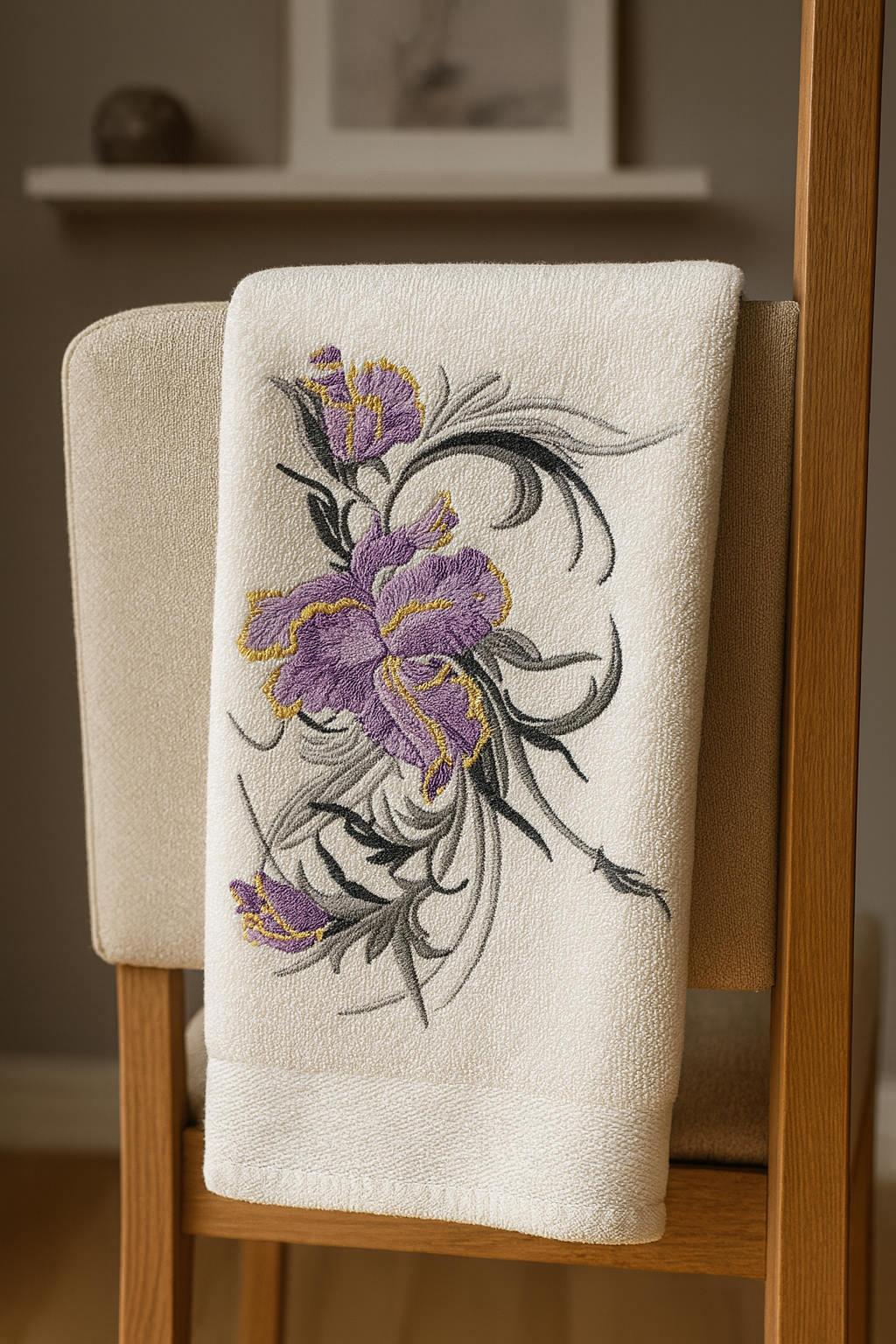How to Embroider Towels Like a Professional: Fabrics, Tips
- bamboo towels embroidery
- big swirl iris embroidery design
- cotton towel embroidery
- custom embroidered gifts
- embroidered gifts
- embroidery on towels
- embroidery stabilizers
- linen towels
- machine embroidery on towels
- machine embroidery tips
- microfiber towels
- towel embroidery
- towel embroidery designs
- towel embroidery tips
Embroidery on Towels: Turning Everyday Textiles into Elegant Accents
Machine embroidery can transform a simple towel into a refined decorative item or a meaningful gift. Whether it’s a floral motif like the Big Swirl Iris embroidery design, a monogram, or a seasonal pattern, embroidery adds character and luxury. But to achieve high-quality results, it’s important to understand the fabrics used for towels and how they affect embroidery.
Choosing the Right Towels for Embroidery
Not all towels are created equal. The type of fabric determines how well the embroidery will hold, how vibrant the threads will look, and how durable the result will be after repeated washes.
1. Cotton Terry Cloth
Most common choice for towels.
Soft, absorbent, and widely available.
Loops in terry fabric can “swallow” embroidery stitches, so using a water-soluble stabilizer on top is essential.
💡 Pro Tip: Always use a topping stabilizer to prevent stitches from sinking into the loops.
2. Bamboo Towels
Known for being eco-friendly, antibacterial, and highly absorbent.
Softer texture than cotton.
Slightly more slippery surface requires careful hooping and stabilizer use.
💡 Pro Tip: Use a cutaway stabilizer for durability, as bamboo fabrics can stretch under embroidery.
3. Microfiber Towels
Lightweight, fast-drying, and affordable.
Smooth surface makes embroidery easier compared to terry cloth.
However, they are less luxurious in feel and not as absorbent.
💡 Pro Tip: Choose bold, high-contrast designs to stand out on microfiber’s flat weave.
4. Linen Towels
Less common, but excellent for decorative embroidery (e.g., kitchen towels or guest towels).
Strong fibers and smooth weave provide a perfect base for detailed designs.
Not as absorbent as cotton, so they are more decorative than functional.
💡 Pro Tip: Linen is ideal for monograms and fine-line floral embroidery.
Numbers Speak: Materials in Towel Production
Based on textile industry reports, here’s how towel production is distributed by fabric type worldwide:
Cotton Towels – 68% (most widely used, especially for bath and hand towels)
Bamboo Towels – 12% (growing market due to eco-demand)
Microfiber Towels – 15% (popular for sports and travel)
Linen Towels – 5% (mainly decorative and luxury items)
This means over two-thirds of embroidered towels are done on cotton terry cloth, making it the most important fabric to master.
Professional Tips for Perfect Towel Embroidery
📌 Use the right stabilizer – Water-soluble topping for terry loops; cutaway or tearaway for extra support.
📌 Select bold designs – High stitch density and strong outlines stand out best.
📌 Test before you stitch – Always run a test design on a scrap piece of the same towel fabric.
📌 Choose thread wisely – Polyester thread is recommended because it withstands frequent washing and bleach better than rayon.
📌 Hooping matters – Avoid stretching the towel too much, as it can distort the embroidery.
Inspiration: Big Swirl Iris Embroidery Design 🌸
The towel in the photo features a Big Swirl Iris embroidery design. The deep purple and yellow details beautifully contrast against the white terry cloth, creating a luxurious, hand-crafted look. Designs like this elevate towels from practical items to gifts, wedding accents, or home décor statements.
Final Thoughts
Embroidering on towels blends practicality with artistry. With the right fabric choice, stabilizers, and embroidery designs, you can create textiles that are both functional and beautiful. Whether it’s for your own home or a handmade gift, embroidered towels are always a touch of elegance.



Recommended Comments
Join the conversation
You can post now and register later. If you have an account, sign in now to post with your account.